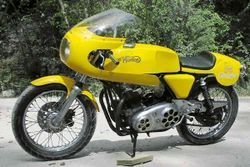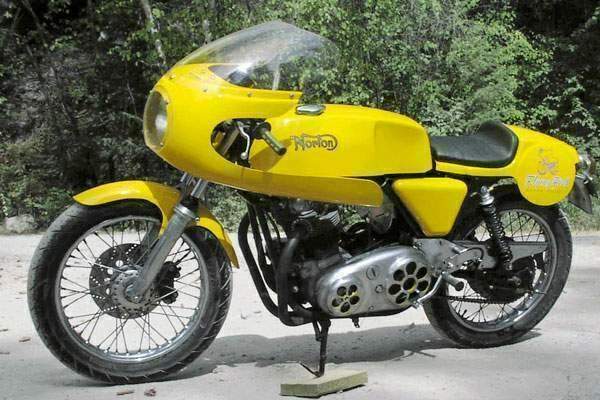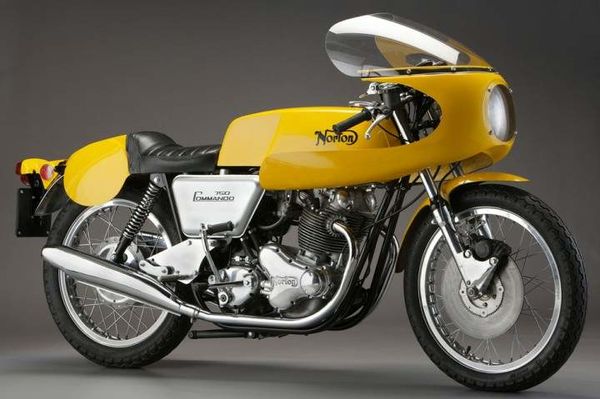Ommando Production Racer
 |
|
| Racing Bikes ommando Production Racer | |
| Production | 1971 |
|---|---|
| Class | Racing |
| Engine | Parallel twin cylinder, 4-stroke, OHV |
| Compression ratio | 10.25:1 |
| Top Speed | 211 km/h / 131 mph |
| Ignition | Boyer electronic ignition |
| Transmission | 5 Speed Rod Quaife gearbox, close ratio |
| Suspension | Front: Telescopic forks Rear: Dual shocks, swingarm |
| Brakes | Front: Single disc Rear: Drum |
| Weight | |
| Fuel Capacity | 22.7 L / 6 US gal |
| Manuals | Service Manual |
It could reach a top speed of 211 km/h / 131 mph.
Engine[edit | edit source]
The engine was a Air cooled cooled Parallel twin cylinder, 4-stroke, OHV. The engine featured a 10.25:1 compression ratio.
Chassis[edit | edit source]
Stopping was achieved via Single disc in the front and a Drum in the rear. The front suspension was a Telescopic forks while the rear was equipped with a Dual shocks, swingarm. The ommando Production Racer was fitted with a 22.7 L / 6 US gal fuel tank.
Photos[edit | edit source]
Overview[edit | edit source]
Norton Commando 750 Production Racer
The Life and Times of the Yellow Submarine The Norton Commando Production Racer: More than a Café racer, less than a GP bike.
When some wealthy collector finally builds the ultimate motorcycle museum and designates one wing as the Hall of Influential Motorcycles, it's not likely future visitors will see a Norton Commando Production Racer there. By most of the accepted methods of the definition, the bike simply wasn't that important, especially outside Great Britain. It began life as a race-shop project, was launched as a marketing gimmick and, after a brief spurt of dominance and popularity on the British and European racetracks, went the way of other, suddenly uncompetitive racing machines. Which is to say, into oblivion and numberless pieces. And yet there exists reason to think otherwise of the bike the British press instantly christened the "Yellow Submarine" on its debut at the Racing and Sporting Motorcycle show in London in a freezing January in 1971. The substance of the reasonbolstered by a healthy dose of 20/20 hindsightis that the Commando Production Racer exists as one of, if not the ultimate development of the motorcycle format the British were to stamp as their own after World War II. This Production Racer a box-stock, genuine factory-built device, not some "prodified" aftermarket machine could well be considered the Ultimate British Vertical Twin. Assuredly, there are Triumph Bon-nevilles being sold as new even today. But even the most wide-eyed Bonnie fan will have to admit that actual development of that machine stopped well before the workers' co-op began building the bike in the mid-Seventies. Only Norton, of all the British bike manufacturers, attempted to come to grips with the inherent vibration of a big OHV vertical twin, and thus only Norton's Isolastic-framed Commando, designed by Bob Trigg and launched in 1968, can be said to have dragged the venerable old vertical twin into the postwar world. Thus by the ineluctable process of logic, if the Commando street bike was the last word in vertical twins from Britain, then the Production Racer was the exclamation point at the end of the sentence. It was the fastest, best-handling, lightest and quickest Commando you could buy. A few performance figures from its era underscore the last point dramatically. A stock Commando SS (a high-pipe version sold to Americans looking for "street scrambler" machismo) consistently knocked off 12.6-second, 100-plus mph quarter-mile times in magazine tests of the day. And when Tony Murphy took a '72 Production Racer to Willow Springs, former Norton factory rep Brian Slark reports, he got the bike around in less than 1:40. Considering that the lap record at the time the absolute lap record, Slark further noteswas around 1:36, the motorcycle had to be taken very seriously indeed as a racing machine. In England, nobody had to be told. Built in batches by Peter Inchley's famous "Long Shop" race department team (the name comes from the long Nissen hut the shop called home, a building dating from the time Thruxton Circuit was Thruxton Aerodrome, home to a B-17 bomber wing of the Eighth Air Force), the Production Racers were at first hard to come by. By late 1971, the Marketing Department at Norton had allocated enough to the race shop to insure that any production-race grid in England would show at least a dozen bikes and more often than not, that one of them would win the race. Some of this was due to simple saturationnobody else at the time built a race-ready production racer for the classbut most of it was due to the quality of Inchley's work. To turn the street bike rolling-chassis that got delivered from the Andover factory to the Long Shop into a Production Racer, Inchley and development engineer factory racer Peter Williams had fine-tuned the original Wally Wyatt project racer of 1969 considerably. Making use of the Long Shop's proximity to the Thruxton circuit (as in: It's in the front yard, mate), Williams and Inchley used run-it-and-see development as well as the tried and true engine tweaks known to work on the old Atlas 750cc engine. The few bikes that emerged from the Long Shop (estimates vary from less than 100 to less than 200 and documentation might as well be nonexistent) proved the worth of the work, because in 1971, '72 and most of '73, they virtually owned their class in England and Europe. Only the arrival of the Kawasaki Z-l and the curing of the Honda CB750Kl's handling ills finally put them on their trailers. The bike pictured here is typical of the breed. Built in October 1971 and sold in January 1972, it incorporates most of the midcourse corrections made to the Production Racer line. The frame, shocks, swingarm and bottom half of the engine are standard Commando parts, but everything else has the Long Shop stamp on it. First are the tires; Dunlop K81 TTlOOs were standard, but instead of the street bike's symmetrical 4.10x19s front and rear, the racer got a 3.60 front section as a result of Thruxton fiddling. The street's steel rims gave way to Akront WM3 40-spoke alloy wheels, and the front drum of the Roadster was replaced by a Campagnolo-and-Lockheed leading-caliper disc, the iron disc being bolted and splined to the front alloy hub. The fork valving was hand-worked using the stock sliders and tubes, again based on racetrack experience. And the stock Isolastic mounts were discarded in favor of new, less resilient mounts. A built-up alloy head-steady replaced the soft stock item. Further chassis changes included the obvious visual ones: the handmade alloy footpeg plates, the pegs themselves (hand-turned, of course, out of solid aluminum), the exhaust pipe bracketry and even the pipes, which were standard items hand-cut and rewelded to tuck in tightly against the frame for cornering clearance. Only the class-required equipment was left on the bike; speedo, tach, lights, horn, stoplight switch. Not a single creature comfort unnecessary to winning races was left aboard. The fiberglass fairing, five-gallon (U.S.) fuel tank and solo-seat-cum-number-plates were designed in-house but built by local industry; Mike Jackson, currently Sales Director of Andover Norton Ltd. believes the pieces were made by Avon, only a few miles from the Andover factory. Likewise, with the exception of the valve springs (which came from S&W in America), the engine pieces were made either in Thruxton or nearby. The head was alloy, gas-flowed and machined with no squish bands, a configuration which, with the slightly domed forged pistons, gave a compression ratio of 10.25:1. Together with the special phosphor bronze valve guides and seats, the larger intake valves and large steel manifolds and 32mm Amal Racing Concentric or remote-float GP "Matchbox" carbs, the package was good for 70 hp at 7000 rpm. A Boyer electronic ignition kit was offered as an option, as was a five-speed Rod Quaife gearbox, which had much closer ratios than the four-speed racing unit that was standard. By the time the Yellow Submarines made their debut, many aftermarket manufacturers had already outfitted Commandos, of course. The huge late-Sixties British Café racer market demanded it, even if the real-racer contingent didn't. So there were quite a few Dunstall Commandos and others to give the Submarines a run for their money. But the hours of Thruxton testing paid off, and the factory product quickly earned a reputation as hard to beat. The genesis of this reputation wasn't merely the lack of suitable competition. The traditional Commando qualities were elevated to their highest pitch in the Submarine, and it was really those qualities that set it on the trail to victory. Because of the engine's vast reservoir of torque, the Commando pilot could dial his speed as though his twistgrip were a rheostat. Further, the standard Commando's fundamental agility was sharpened by the chassis tweaks of the Submarine until the bike was so stable and responsive that it could be ridden anywhere on the track, whether on a long straight or off-camber decreasing-radius turn. The generous (for the time) suspension travel gave the Production Racer a soft ride almost unknown among racers of the day, allowing the rider to concentrate on racing rather than just staying aboard. At long tracks notably the Isle of Manthe fatigue-reducing aspects of the Commando played a decisive role, for coupled to the plush suspension and superbly comfortable riding position were the Isolastic engine mounts, which sopped up virtually all the bad vibes the bike's vintage engine offered up. As a result of this honing of the standard Commando's best characteristics, the word got to Europe's (and even, to some extent, America's) street riders that the Commando won its races not because it was hand-grenade quick or ridden by win-or-die kamikaze pilots, but because it was somehow fundamentally different from all the other Britbikes that had soldiered on with vertical twins in the past. Which was, from the company's point of view, what the whole exercise was all about. Confronting a swelling tide of Japanese "big bikes," Norton's management tried to cover as many marketing bases as possible; there were touring Commandos, "street-scrambler" Commandos and even the awful and unlamented Hi-Rider, which was nothing more than a Commando Roadster with ape-hanger handlebar and kicked-up seat, all led by a tiny headlight. But as the Japanese took over more and more of the market, only the "sporting" aura clung successfully to the Commando. And the factory sources we spoke with agreed that the legend of the Commando's roadholding and sport-sense derived directly from the Production Racer's brief dominance on the racetrack. Considering that the Commando lived for seven years, most of them in the face of ever-more exciting Japanese machinery, a new BMW series, the all-new Ducati vee-twin 750s, the Laverda SFC and following Café bikes in the face, in fact, of the biggest motorcycle explosion since WWII the contribution of the racer might almost qualify it for inclusion in the Hall of Influential Motorcycles. But only almost. Had the Commando lived indeed, had Norton itself lived as a major manufacturing concern of big-inch motorcycles a niche would be certain for the Yellow Submarine. But since Norton, like BSA, Triumph and all the rest of England's long-gone manufacturers eventually succumbed to self-inflicted wounds, the Hall will not see a Commando Production Racer. Instead, it will find its way into the garages of curio collectors, its epitaph a simple one. "Here rests the Norton Commando Production Racer. Beautiful, fast, British and too late."
Source BY STEVE THOMPSON
| Make Model | Norton Commando 750 Production Racer |
|---|---|
| Year | 1971 |
| Engine Type | Parallel twin cylinder, 4-stroke, OHV |
| Displacement | 745 cc / 45.5 cu in |
| Bore X Stroke | 73 x 89 mm |
| Compression | 10.25:1 |
| Cooling System | Air cooled |
| Induction | 2 x Ø32 mm Amal GP carburetors |
| Ignition | Boyer electronic ignition |
| Starting | Electric and kick |
| Max Power | 52 kW / 70 hp @ 7000 rpm |
| Transmission | 5 Speed Rod Quaife gearbox, close ratio |
| Final Drive | Chain |
| Front Suspension | Telescopic forks |
| Rear Suspension | Dual shocks, swingarm |
| Front Brakes | Single disc |
| Rear Brakes | Drum |
| Front Wheel | 3.60 x 19" Aluminum |
| Rear Wheel | 4.10 x 19" Aluminum |
| Fuel Capacity | 22.7 L / 6 US gal |
| Dry-weight | 182 kg / 400 lbs |
| Top Speed | 211 km/h / 131 mph |

